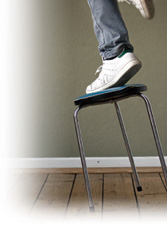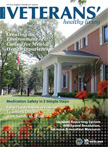Veterans' Healthy Living, Spring 2014
Tips to Keep Your Feet Firmly Planted
Every year, falls send almost 9 million people to emergency rooms and result in about 25,000 deaths!1 In fact, you have probably fallen or you know someone who has. People of all ages fall— and it is usually preventable! (How many of the following hazards are present in your home?)
Common causes of falls include wet flooring or spills on floors or other walking surfaces. Dry products like dust, powder, or granules can also cause an accident, and highly polished or freshly waxed flooring is slick even when dry.
Uneven surfaces or a change of surface, such as carpet to vinyl, can be tricky, as can loose rugs or mats. Outdoors, weather conditions like rain or ice are hazardous, but so are leaves and plant debris, mud, gravel, and uneven terrain. Indoors and out, many accidents happen when people trip over an obstacle in their path—a garden hose, a box, an electrical cord, or even a frisky pet!
 We are more prone to slips, trips, and falls as we age, but people of all ages can fall due to the effects of fatigue, stress, edications, or alcohol. Similarly, anyone can fall from carrying too heavy or too cumbersome an object, lack of attention to surroundings, or simply being in too big of a hurry!
We are more prone to slips, trips, and falls as we age, but people of all ages can fall due to the effects of fatigue, stress, edications, or alcohol. Similarly, anyone can fall from carrying too heavy or too cumbersome an object, lack of attention to surroundings, or simply being in too big of a hurry!
Inside, keep frequently used items in easily accessible areas. If that isn’t possible, stand on a sturdy stepstool instead of a chair or table to extend your reach. Obviously, a job that requires climbing, such as painting, or roof or gutter repair, requires using the right type of equipment (ladder, scaffold, etc.), understanding how to use it properly, and avoiding the temptation to stretch outside your comfort zone.
Other preventative measures include checking your home inside and out for poorly lit walkways, damaged steps (or stairways), and missing handrails. Keep walkways clean, dry, and clear of clutter and cords, and use only non-skid rugs or mats. Also, don’t underestimate the importance of footwear that fits well and offers good traction.
Injuries from a fall can be minor, ranging from bumps and bruises to a sore muscle to a broken arm or leg. But falls can cause lost wages, disability, and reduced quality of life. In fact, falls are the second leading cause of accidental death for Americans after traffic collisions.2 Be informed and be safe!
1National Safety Council
2National Institutes of Health
To learn more about how to prevent a fall, visit the Veterans Health Library information at
http://www.veteranshealthlibrary.org/Encyclopedia/142,89339_VA.
Mental Health Unit | Medication | Patient Safety Residency | Preventing Falls | Incident Reporting

















